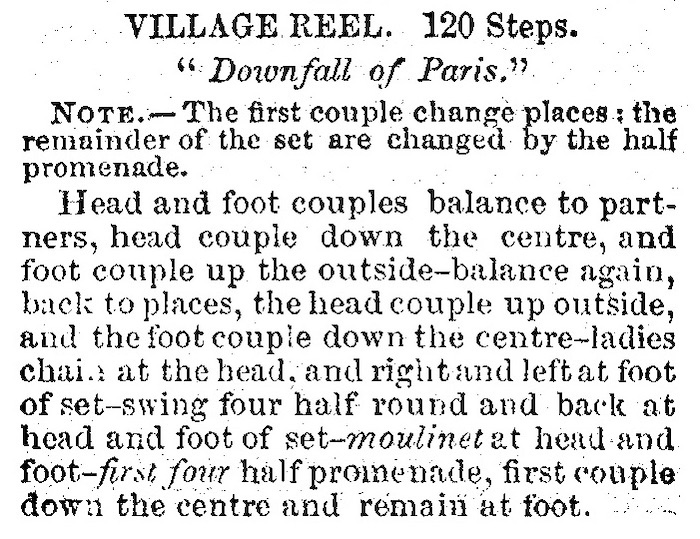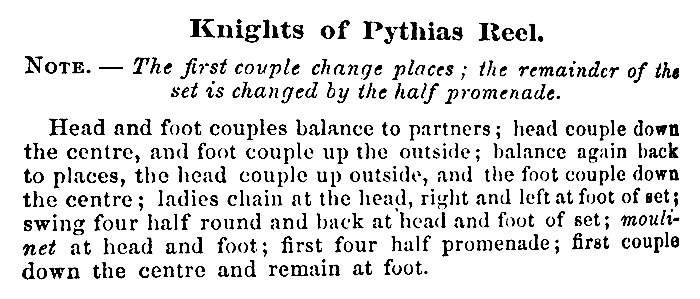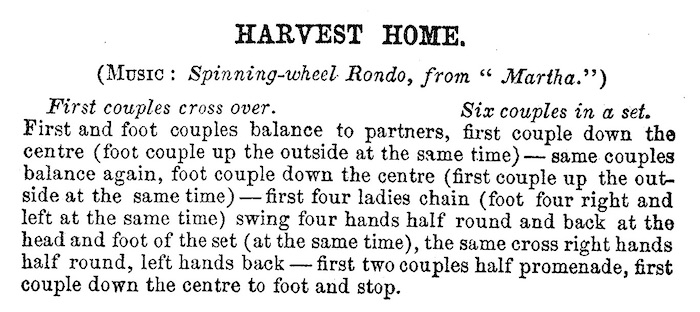Long, long, ago I published a reconstruction of the mid-19th century American contra (country) dance published as “Harvest Home” in some of Elias Howe’s dance compilations. I have nothing new to add to that reconstruction, but as I’ve collated more and more contra dances of that era, I’ve found the same figures under a couple of other names in other source, including one predating Howe’s publication of it, with a suggestive pattern of differences.
A quick timeline; full citations are at the end of the post:
1856 (Quimby) “Village Reel”
1858 (anonymous New Hampshire) “Village Reel”
1858 (Howe) “Harvest Home”
1862 (Howe) “Harvest Home”
1863 (Quimby) “Village Reel”
1882 (Howe) “Harvest Home” and “Knights of Pythias Reel”
1892 (Howe) “Harvest Home” and “Knights of Pythias Reel”
How similar are the instructions in all of these sources? Very. They are clearly identical figures. The only differences between them are minor variations in phrasing or terminology. Some, I would classify as not significant:
– the earliest source (1856) uses “middle”, as in “down the middle”, while all the others use “centre”
– the two earliest sources describe the setup “at the commencement of the dance”, while the others omit these words
– the Quimby sources give the dance “120 steps”, which is a way of counting length specific to those two works
– semicolons, commas, and dashes are variously used to separate figures
But the other variations reveal an interesting pattern of differences between two distinct sets of sources. Contrast:
(A) the “Village Reel” sources and “Knights of Pythias Reel”
– do not specify number of couples
– first couple or couples at head “change places”
– “the remainder of the set are changed by the half promenade.”
– “head” couple
– “moulinet”
– “at the head”
– “at foot of set”
– “swing four”
– “first four”
(B) “Harvest Home”
– specifies six couples in a set
– first couples “cross over”
– no note about the remainder of the couples
– “first” couple
– “cross right hands half round, left hands back”
– “first four”
– “foot four”
– “swing four hands”
– “first two couples”
Here are a trio of sample images (click to enlarge) in which one may see the similarities and differences:

All the “Village Reel” sources use this phrasing

Uses the same phrasing as the “Village Reel” sources

Uses variant phrasing as listed above
Drawing definite conclusions from this sort of thing is tricky, since there was such wholesale copying between sources in this era. I would hypothesize that Howe had a slightly different calling vocabulary than some of his contemporaries, and that this difference is visible in descriptions he himself wrote, but that dances that were just copied into his publications were not necessarily rewritten. “Knights of Pythias Reel” might have been simply a flattering rename of “Village Reel” – the Knights of Pythias were founded in 1864 – with the dance copied word for word into the 1882 Howe and the 1892 edition merely reprinting it. This is supported by my inability to find any tune called “Knight of Pythias Reel”.
To confirm this, one would have to try to distinguish Howe’s descriptions from those he simply copied in (not an easy task) and then compare his descriptions with those of others in bulk. That would be a substantial project, to say the least.
A Music note
The two Quimby/Washburn editions both give “Downfall of Paris” for the tune. All but the earliest (1858) Howe collections give “Spinning-wheel Rondo from ‘Martha’” when the dance is listed under “Harvest Home”., but nothing under “Knights of Pythias Reel”. I would conclude from this that while “Harvest Home”, “Downfall of Paris” and “Spinning-wheel Rondo” are all valid options, it is not particularly important to use a specific tune.
Sources cited
W. H. Quimby (presumed), The Ball Room Manual, Revised Edition (Belfast, Maine, 1856)
Anonymous, The Ball Room Guide (Laconia, N.H., 1858)
W. H. Quimby (presumed), The Ball Room Manual, Vest Pocket Edition (Belfast, Maine, and Boston, 1863)
Elias Howe, Howe’s Complete Ballroom Handbook (Boston, 1858)
Elias Howe, American Dancing Master and Ball-Room Prompter (Boston, 1862)
Elias Howe, Howe’s New American Dancing Master (Boston, 1882)
Elias Howe, Howe’s New American Dancing Master (Boston, 1892)


Leave a Reply